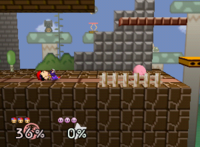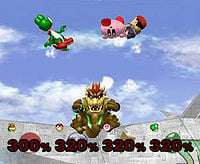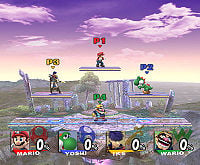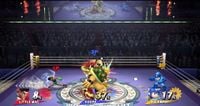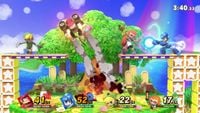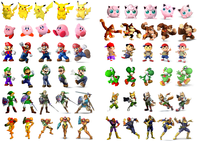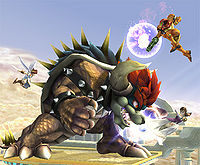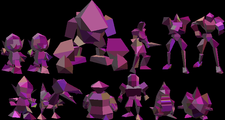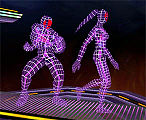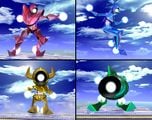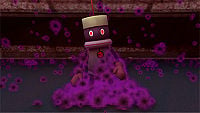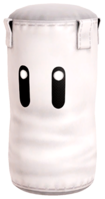Super Smash Bros. (series): Difference between revisions
(→Super Smash Bros. Ultimate: The Kongo Falls screenshot wasn't a good example. "GO!" covered so much of the screen that you could only see King K. Rool.) |
m (Undid edit by 38.137.236.152: Vandalism) Tag: Undo |
||
| (208 intermediate revisions by 89 users not shown) | |||
| Line 1: | Line 1: | ||
{{ | {{Title|''Super Smash Bros.'' (series)}} | ||
{{ArticleIcons|series=y}} | {{ArticleIcons|series=y}} | ||
{{Wikipedia}} | {{Wikipedia|Super Smash Bros.}} | ||
[[File:Super Smash Bros. for Nintendo Switch.svg|300px|thumb|The current logo of the ''Super Smash Bros.'' series]] | [[File:Super Smash Bros. for Nintendo Switch.svg|300px|thumb|The current logo of the ''Super Smash Bros.'' series]] | ||
'''''Super Smash Bros.''''', known in Japan as '''''Dairantō Smash Brothers''''' ({{ja|大乱闘スマッシュブラザーズ|Dairantō Sumasshu Burazazu}}, ''Great Fray Smash Brothers''), | '''''Super Smash Bros.''''', known in Japan as '''''Dairantō Smash Brothers''''' ({{ja|大乱闘スマッシュブラザーズ|Dairantō Sumasshu Burazazu}}, ''Great Fray Smash Brothers''), commonly known as '''''Smash Bros.''''' ({{ja|スマブラ|Sumabura}}) or '''''Smash''''', stylized as '''''SUPER SMASH BROS.''''', is a series of crossover fighting games published by [[Nintendo]], featuring characters from franchises established on Nintendo systems. The series had a successful start in 1999 with the game ''[[Super Smash Bros.]]'' released on the [[Nintendo 64]]. It achieved even greater success with ''[[Super Smash Bros. Melee]]'', released in 2001 for the [[Nintendo GameCube]], becoming the best selling game on that system. The third installment, ''[[Super Smash Bros. Brawl]]'', was released on the [[Wii]] throughout the year of 2008. The fourth game in the series, ''[[Super Smash Bros. 4]]'', was first released for the [[Nintendo 3DS]] in September 2014, while the [[Wii U]] version was first released in November 2014. The most recent game in the series, ''[[Super Smash Bros. Ultimate]]'', was released for the [[Nintendo Switch]] on December 7, 2018. [[Masahiro Sakurai]] has directed all five games despite [[HAL Laboratory]] handing the series to a new developer for ''Brawl''.<ref>{{cite web|url=http://www.smashbros.com/en/story/page_3.html|archiveurl=https://web.archive.org/web/20060717223706/www.smashbros.com/en/story/page_3.html|archivedate=2006-07-17|title=How this Game Came to be Made|author=Masahiro Sakurai|work=Smash Bros. DOJO!!|publisher=smashbros.com}}</ref> | ||
==History== | ==History== | ||
===''Super Smash Bros.''=== | ===''Super Smash Bros.''=== | ||
[[File: | [[File:Ness VS Kirby Stock Match.png|200px|thumb|{{SSB|Ness}} fighting {{SSB|Kirby}} on the {{SSB|Mushroom Kingdom}} stage.]] | ||
{{main|Super Smash Bros.}} | {{main|Super Smash Bros.}} | ||
''Super Smash Bros.'' was introduced in 1999 for the [[Nintendo 64]]. It was released worldwide after selling over a million copies in Japan. It featured eight characters from the start | ''Super Smash Bros.'' was introduced in 1999 for the [[Nintendo 64]]. It was released worldwide after selling over a million copies in Japan. It featured 12 playable characters (eight characters from the start and four unlockable characters), all of them created by Nintendo or one of its second-party developers. | ||
In the multiplayer (Versus) mode, up to four people can play, with the specific rules of each match being predetermined by the players. There are two different types that can be chosen: Time, where the person with the most KOs at the end of the set time wins; and stock, where each person has a set amount of lives, and when it is gone, the player is eliminated. | In the multiplayer (Versus) mode, up to four people can play, with the specific rules of each match being predetermined by the players. There are two different types that can be chosen: Time, where the person with the most KOs at the end of the set time wins; and stock, where each person has a set amount of lives, and when it is gone, the player is eliminated. | ||
This game's one-player mode included an adventure mode that always followed the same series of opponents, although the player could change the difficulty. Other single player modes exist such as Training and several mini-games, including [[Break the Targets]] and [[Board the Platforms]]. All of these were included in the sequel, with the exception of "Board the Platforms". | This game's one-player mode included an adventure mode that always followed the same series of opponents, although the player could change the difficulty. Other single-player modes exist such as Training and several mini-games, including [[Break the Targets]] and [[Board the Platforms]]. All of these were included in the sequel, with the exception of "Board the Platforms". | ||
In Versus mode, there are nine playable stages | In Versus mode, there are nine playable stages. However, there are eight stages available from the start; and are based on each of the [[starter character]]s (including [[Peach's Castle]] for {{SSB|Mario}}, [[Congo Jungle]] for {{SSB|Donkey Kong}}, [[Hyrule Castle]] for {{SSB|Link}}, [[Planet Zebes]] for {{SSB|Samus Aran}}, {{SSB|Yoshi's Island}} for {{SSB|Yoshi}}, {{SSB|Dream Land}} for {{SSB|Kirby}}, [[Sector Z]] for {{SSB|Fox McCloud}}, and [[Saffron City]] for {{SSB|Pikachu}}), and the unlockable {{SSB|Mushroom Kingdom}} (which is the one [[unlockable stage]]). | ||
===''Super Smash Bros. Melee''=== | ===''Super Smash Bros. Melee''=== | ||
[[File:SpecialMelee.jpg|200px|thumb|{{SSBM|Bowser}} attacks {{SSBM|Ness}}, {{SSBM|Kirby}} and {{SSBM|Yoshi}} in | [[File:SpecialMelee.jpg|200px|thumb|{{SSBM|Bowser}} attacks {{SSBM|Ness}}, {{SSBM|Kirby}} and {{SSBM|Yoshi}} in [[Super Sudden Death]] mode on the Great Fox in [[Corneria]].]] | ||
{{main|Super Smash Bros. Melee}} | {{main|Super Smash Bros. Melee}} | ||
''Super Smash Bros. Melee'' was released November 21, 2001 in Japan; December 3, 2001 in the Americas; May 24, 2002 in Europe; and May 31, 2002 in Australia for the [[Nintendo GameCube]] console. It had a larger budget and development team than | ''Super Smash Bros. Melee'' was released November 21, 2001 in Japan; December 3, 2001 in the Americas; May 24, 2002 in Europe; and May 31, 2002 in Australia for the [[Nintendo GameCube]] console. It had a larger budget and development team than its predecessor did and was released to much greater praise and acclaim among critics and consumers. Since its release, ''Super Smash Bros. Melee'' has sold more than 7 million copies and was the best-selling game on the GameCube.<ref>{{cite web | url=http://biz.gamedaily.com/industry/feature/?id=14501 | title=Opinion: Wii Won't Rock You | author=David Radd | publisher=GameDaily | accessdate=2006-11-27 | date=2006-11-17}}</ref> | ||
''Super Smash Bros. Melee'' features | ''Super Smash Bros. Melee'' features twenty-six playable characters; of which 15 are available initially (more than doubling the number of characters in its predecessor). Altogether, 15 characters are [[starter character]]s and 11 are [[unlockable character]]s). There are also twenty-nine playable stages (however, 18 stages are [[starter stage]]s and 11 are [[unlockable stage]]s). It introduced two new single-player modes alongside the {{SSBM|Classic Mode}}; [[Adventure]], and [[All Star]]. ''Adventure'' has platforming segments similar to the original's "Race to the Finish" minigame, and ''All-Star'' is a fight against every playable character in the game, allows the player only one life in which damage is accumulated over each battle, and the character is allowed to use only three recovery items which heal all taken damage in between battles. There are also significantly more multiplayer modes and a tournament mode allowing for 64 different competitors whom can all be controlled by a human player, although only up to four players can participate at the same time. Additionally, the game featured alternative battle modes, called "Special Melee," which involve some sort of alteration to the battle (ex: all characters are giant by default, players may only use their jump and standard attack buttons, etc.), along with alternative ways to judge a victory, such as through collecting coins throughout the match. In addition, the game introduced the [[Home-Run Contest]], where players use a [[Home-Run Bat]] to send Sandbag flying while damaging it for ten seconds. | ||
In place of ''Super Smash Bros.''' character profiles, ''Melee'' introduced trophies (called "figures" in the Japanese version). The 293 trophies include three different profiles for each playable character, one unlocked in each single-player mode. In addition, unlike its predecessor, ''Melee'' contains profiles for many Nintendo characters who are either non-playable or do not appear in the game, as well as Nintendo items, stages, enemies, and elements. | In place of ''Super Smash Bros.''' character profiles, ''Melee'' introduced trophies (called "figures" in the Japanese version). The 293 trophies include three different profiles for each playable character, one unlocked in each single-player mode. In addition, unlike its predecessor, ''Melee'' contains profiles for many Nintendo characters who are either non-playable or do not appear in the game, as well as Nintendo items, stages, enemies, and elements. | ||
===''Super Smash Bros. Brawl''=== | ===''Super Smash Bros. Brawl''=== | ||
[[File:SSBB Gameplay.jpg|thumb|200px|{{SSBB|Mario}}, {{SSBB|Yoshi}}, {{SSBB|Ike}} and {{SSBB|Wario}} preparing to fight on the {{SSBB|Battlefield}} stage]] | [[File:SSBB Gameplay.jpg|thumb|200px|{{SSBB|Mario}}, {{SSBB|Yoshi}}, {{SSBB|Ike}} and {{SSBB|Wario}} preparing to fight on the {{SSBB|Battlefield}} stage.]] | ||
{{main|Super Smash Bros. Brawl}} | {{main|Super Smash Bros. Brawl}} | ||
Although a third ''Super Smash Bros.'' game had been announced long before E3 2006, Nintendo unveiled its first information in the form of a trailer on May 10, 2006, and the game was named ''Super Smash Bros. Brawl''. The trailer featured [[Solid Snake]], of {{s|wikipedia|Konami}}'s {{uv|Metal Gear}} fame, marking the first time that a third-party character had been introduced as a playable character in a ''Super Smash Bros.'' title. A second third-party character, [[Sonic the Hedgehog]], from Nintendo's former rival {{s|wikipedia|Sega}} was also confirmed as a playable character on October 10, 2007. ''Brawl'' is also the first game in the franchise to support online play via the [[Nintendo Wi-Fi Connection]].<ref>{{cite web|url=http://www.smashbros.com/wii/en_us/gamemode/wi-fi/wi-fi01.html|title=Wi-Fi Play|accessdate=2007-09-18|date=2007-09-18|work=Smash Bros. DOJO!!|publisher= | Although a third ''Super Smash Bros.'' game had been announced long before E3 2006, Nintendo unveiled its first information in the form of a trailer on May 10, 2006, and the game was named ''Super Smash Bros. Brawl''. The trailer featured [[Solid Snake]], of {{s|wikipedia|Konami}}'s {{uv|Metal Gear}} fame, marking the first time that a third-party character had been introduced as a playable character in a ''Super Smash Bros.'' title. A second third-party character, [[Sonic the Hedgehog]], from Nintendo's former rival {{s|wikipedia|Sega}} was also confirmed as a playable character on October 10, 2007. ''Brawl'' is also the first game in the franchise to support online play via the [[Nintendo Wi-Fi Connection]].<ref>{{cite web|url=http://www.smashbros.com/wii/en_us/gamemode/wi-fi/wi-fi01.html|title=Wi-Fi Play|accessdate=2007-09-18|date=2007-09-18|work=Smash Bros. DOJO!!|publisher=smashbros.com}}</ref> The game was released on January 31, 2008 in Japan, and on March 9th for North America. | ||
''Brawl'' also features compatibility with four kinds of controllers (the [[Wii Remote]] | ''Brawl'' also features compatibility with four kinds of controllers (the [[Wii Remote]] turned sideways, the Wii Remote and [[Nunchuk]] combination, the [[Classic Controller]], and the [[Nintendo GameCube controller]]),<ref>{{cite web|url=http://www.smashbros.com/wii/en_us/gamemode/various/various01.html|title=Four Kinds of Control|work=Smash Bros. DOJO!!|publisher=smashbros.com}}</ref> while its predecessors only used the one controller designed for that system. The player also has the ability to change the configuration of controls and the controller type.<ref>{{cite web|url=http://www.smashbros.com/wii/en_us/gamemode/various/various02.html|title=Names|work=Smash Bros. DOJO!!|publisher=smashbros.com}}</ref> | ||
===''Super Smash Bros. 4''=== | ===''Super Smash Bros. 4''=== | ||
{{main|Super Smash Bros. 4}} | {{main|Super Smash Bros. 4}} | ||
[[File:DamageMeterSSB4.jpg|thumb| | {{see also|Super Smash Bros. for Nintendo 3DS}} | ||
At E3 2011, it was announced that there will be a fourth entry in the ''Super Smash Bros.'' franchise. The game is available on the [[Nintendo 3DS]] and | {{see also|Super Smash Bros. for Wii U}} | ||
[[File:DamageMeterSSB4.jpg|thumb|200px|{{SSB4|Little Mac}}, {{SSB4|Bowser}}, and {{SSB4|Mega Man}} fighting in the Wii U version of the game.]] | |||
At E3 2011, it was announced that there will be a fourth entry in the ''Super Smash Bros.'' franchise. The game is available on the [[Nintendo 3DS]] and the [[Wii U]]. Development began in late February 2012, and the 3DS version was released on September 13th, 2014 in Japan, and was released on October 3rd, 2014 internationally, while the Wii U version was released on November 21st, 2014 in the Americas, on November 28th, 2014 in Europe, on November 29th, 2014 in Australia, and on December 6th, 2014 in Japan. | |||
[[Sonic the Hedgehog]] returned as veteran third party fighter from [[Sega]] while new third-parties were also added to this game: [[Mega Man]] from [[Capcom]] and [[Pac-Man]] from [[Bandai Namco]]. Later, when [[DLC]] was announced for the game, [[Ryu]] from {{uv|Street Fighter}} was added as the first DLC | [[Sonic the Hedgehog]] returned as veteran third party fighter from [[Sega]] while new third-parties were also added to this game: [[Mega Man]] from [[Capcom]] and [[Pac-Man]] from [[Bandai Namco]]. Later, when [[DLC]] was announced for the game, [[Ryu]] from {{uv|Street Fighter}} was added as the first DLC newcomers. Then, during the November 12th, 2015 [[Nintendo Direct]], [[Cloud Strife]] from {{uv|Final Fantasy}} was the second DLC newcomer announced, thus adding [[Square Enix]] to the list of third-parties represented in SSB4. Lastly, in the final Smash Bros. Direct special presentation on December 15, 2015, the Smash Bros. Ballot winner, Bayonetta, was announced and revealed. Her inclusion, as well as Ryu's, make Sega and Capcom the first third-party companies in the series to have more than one fighter. | ||
===''Super Smash Bros. Ultimate''=== | ===''Super Smash Bros. Ultimate''=== | ||
[[File:SSBU time battle.jpg|thumb|200px|{{SSBU|Diddy Kong}}, {{SSBU|Mega Man}}, {{SSBU|Toon Link}}, and {{SSBU|Inkling}} | [[File:SSBU time battle.jpg|thumb|200px|{{SSBU|Diddy Kong}}, {{SSBU|Mega Man}}, {{SSBU|Toon Link}}, and {{SSBU|Inkling}} fighting on Green Greens in ''Ultimate''.]] | ||
{{main|Super Smash Bros. Ultimate}} | {{main|Super Smash Bros. Ultimate}} | ||
In October 2014, a fan asked Sakurai if he was done with developing ''Super Smash Bros.'' games, to which he replied, "I'm not done yet...". <ref>{{cite web|url=https://kotaku.com/super-smash-bros-isnt-finished-being-made-1647031197|title=Super Smash Bros. Isn't Finished Being Made|work=Kotaku}}</ref> Despite this, he stated in ''Weekly Famitsu'' that he doubts he could continue game development as a whole if his workload stays the way it was for ''[[Super Smash Bros. 4]]''.<ref>{{cite web|url=http://kotaku.com/smash-bros-could-be-its-creators-last-game-1682483142|title=Smash Bros. Could be its Creator's Last Game|work=Kotaku}}</ref> | |||
On March 8th, 2018, a ''Super Smash Bros.'' game was confirmed for the Nintendo Switch, due out in 2018. The trailer, revealed at the end of the Nintendo Direct that day, suggested that the [[Inkling]]s would be playable. <ref>{{cite web|url=https://www.youtube.com/watch?v=w3Gt42kVgCw|title=Super Smash Bros. is coming to Nintendo Switch!}}</ref> | On March 8th, 2018, a ''Super Smash Bros.'' game was confirmed for the Nintendo Switch, due out in 2018. The trailer, revealed at the end of the Nintendo Direct that day, suggested that the [[Inkling]]s would be playable. <ref>{{cite web|url=https://www.youtube.com/watch?v=w3Gt42kVgCw|title=Super Smash Bros. is coming to Nintendo Switch!}}</ref> | ||
During E3 2018, the title for the next game, ''Super Smash Bros. Ultimate'', was announced alongside | During E3 2018, the title for the next game, ''Super Smash Bros. Ultimate'', was announced alongside several details, including its character roster which includes all characters in the ''Super Smash Bros.'' series, along with Inkling and [[Ridley]] as newcomers, [[Princess Daisy|Daisy]] as an Echo Fighter of Peach, and the return of Xander Mobus as the [[announcer]]. During the ''Super Smash Bros. Ultimate'' Direct on August 8th, [[Simon Belmont]] and his descendant [[Richter Belmont|Richter]] of ''Castlevania'' fame were both announced as new playable fighters, along with [[Dark Samus]] and [[Chrom]] as Echo Fighters and Donkey Kong's arch-enemy, [[King K. Rool]]. Isabelle from ''Animal Crossing'', who appeared in the previous game as an Assist Trophy, was revealed as a playable fighter at the close of the September 2018 Nintendo Direct, along with a teaser for a brand new entry in the ''Animal Crossing'' series on the Switch in 2019. In the second ''Super Smash Bros. Ultimate'' Direct on November 1st, [[Ken Masters]] and [[Incineroar]] were announced as the final fighters to complete the base roster along with the new {{b|Spirits|menu}} mode, a new story called [[World of Light]], a [[Piranha Plant]] as a DLC fighter and the [[Fighters Pass]] Vol. 1, which includes five fighters, five stages and extra music tracks as DLC. The first character of this Fighters Pass Vol. 1 was revealed to be [[Joker]], the main protagonist from ''Persona 5'', at {{h2|The Game Awards|The Game Awards 2018}}. | ||
The game was released worldwide on December 7, 2018. <ref>{{cite web|url=https://www.youtube.com/watch?v=L93H7YC-83o|title=Super Smash Bros. Ultimate - E3 2018 - Nintendo Switch}}</ref> | The game was released worldwide on December 7, 2018. <ref>{{cite web|url=https://www.youtube.com/watch?v=L93H7YC-83o|title=Super Smash Bros. Ultimate - E3 2018 - Nintendo Switch}}</ref> | ||
Piranha Plant was released as the first DLC fighter, free to those who had registered the game on | Piranha Plant was released as the first DLC fighter as a huge surprise, free to those who had registered the game on My Nintendo before the end of January 2019. [[Joker]] was the first Fighters Pass Vol.1 character to be released in April 2019. Subsequent DLC announcements occurred at E3 2019: the [[Hero]] from ''Dragon Quest'', released late July of 2019, and [[Banjo]] & [[Kazooie]], who were released in September 2019. The same month Banjo & Kazooie were released, [[Terry]] from ''Fatal Fury'' was announced as the fourth DLC fighter, and was released in November 2019. That same month, it was announced that more DLC characters were undergoing development to join the roster. In January 2020, [[Byleth]] from ''Fire Emblem: Three Houses'' was announced as the fifth and last Fighters Pass Vol. 1 character, and was released later that same month. It was also revealed that another Fighters Pass would be released, under the title of Fighters Pass Vol. 2, and it would contain six characters: [[Min Min]] from ''[[ARMS]]'', who was announced in March 2020, and was fully revealed/released in June 2020; [[Steve]] from ''[[Minecraft]]'', who was announced and released in October 2020; [[Sephiroth]] from {{uv|Final Fantasy}}, who was announced and released in December 2020; [[Pyra]] and [[Mythra]] as a two-in-one transformation character from ''Xenoblade Chronicles 2'', were announced in February 2021 and released in March 2021; [[Kazuya]] from {{uv|Tekken}}, who was announced and released in June 2021; and [[Sora]] from {{uv|Kingdom Hearts}} as the final downloadable character, who released on October 18, 2021. | ||
==Gameplay== | ==Gameplay== | ||
The ''Super Smash Bros.'' series | The basic gameplay of ''Super Smash Bros.'' series dramatically differs from many fighting games. Instead of depleting an opponent's life bar, ''Smash Bros.'' seeks players to launch characters off the stage. In ''Super Smash Bros.'', characters have a damage total, represented by a percentage value, which rises as they take damage and can exceed 100%. As characters' percentages rise, they can be knocked progressively further by an opponent's attacks. For a character to be KO'd, said character must be sent off the edge of the stage, which is not an enclosed arena but rather an area with open boundaries, usually a set of suspended platforms. If a character travels too far away from the stage in any direction, they lose a stock and potentially lose the entire game. When a character is knocked off the stage, they typically have an opportunity to (attempt to) recover and return; typically by jumping and using attacks that cause the player to travel a significant distance. Some characters have an easier time recovering than others due to a combination of floatier jumps or simply having more jumps available, as well as having attacks with more significant aerial drift. Additionally, some characters are heavier than others, making it harder for an opponent to knock them off the edge but likewise harder to recover. | ||
''Smash Bros.''{{'}}s play controls are greatly simplified in comparison to other fighting games. While traditional fighting games such as | ''Smash Bros.''{{'}}s play controls are greatly simplified in comparison to other fighting games. While traditional fighting games such as {{uv|Street Fighter}} require the player to memorize button-input combinations (sometimes lengthy and complicated, and often specific to a character), ''Smash Bros'' uses the same one-attack-button, one-control-stick-direction combinations to access all moves for all characters. Two buttons are primarily used for attacks: [[normal attack]] button and [[special attack]] button, with the orientation of the [[control stick]] dictating what specific attack is used. Some attacks only activate on the ground, while others only activate while airborne, and some can activate in both scenarios, though functionality may change. Other attacks are activated through non-traditional methods, but these are few and far between. Most characters are not limited to constantly facing their opponent but may move around freely, with some attacks only accessible by tilting the stick opposite where the character is facing. ''Smash Bros.'' also approaches blocking different than other games. Instead of simply holding a direction to block, a dedicated button activates a [[shield]], which depletes with prolonged used and replenishes when not in use, with enemy attacks accelerating the depletion. If a shield fully depletes, the character is [[stun]]ned and at the mercy of their opponent. Using the stick in this shield state can activate various types of [[dodge]]s, which can be used both on the ground and in the air. Grabbing and throwing other characters is also possible, allowing for a large variety of ways to attack. | ||
One additional major element in the ''Super Smash Bros.'' series is the inclusion of battle items, of which players can control the frequency of appearance. There are conventional "battering items" with which a player may hit an opponent, such as a [[Home-Run Bat|baseball bat]] or a [[Beam Sword|sword]], as well as throwing items, including [[Bob-omb]]s and [[Koopa Troopa|shells]], and shooting items, either single shot guns or rapid fire blasters. Recovery items allow the user to lose varying amounts of their damage percent. From the {{uv|Pokémon}} franchise come [[Poké Ball]]s that release a random Pokémon onto the battlefield to assist the user; ''Brawl'' introduces a new "[[Assist Trophy]]" item which serves a similar purpose, albeit being capable of summoning a wider range of characters from a variety of franchises. ''Brawl'' also introduces items called [[Smash Ball]]s, which allows fighters to perform powerful character-specific attacks, known as [[Final Smash]]es. | One additional major element in the ''Super Smash Bros.'' series is the inclusion of battle [[items]], of which players can control the frequency of appearance. There are conventional "battering items" with which a player may hit an opponent, such as a [[Home-Run Bat|baseball bat]] or a [[Beam Sword|sword]], as well as throwing items, including [[Bob-omb]]s and [[Koopa Troopa|shells]], and shooting items, either single-shot guns or rapid fire blasters. Recovery items allow the user to lose varying amounts of their damage percent. From the {{uv|Pokémon}} franchise come [[Poké Ball]]s that release a random Pokémon onto the battlefield to assist the user; ''Brawl'' introduces a new "[[Assist Trophy]]" item which serves a similar purpose, albeit being capable of summoning a wider range of characters from a variety of franchises. ''Brawl'' also introduces items called [[Smash Ball]]s, which allows fighters to perform powerful character-specific attacks, known as [[Final Smash]]es. | ||
==Characters== | ==Characters== | ||
[[File:Returning.png|thumb|Sometimes colloquially referred to as "The Original Twelve", the above characters appeared in ''Super Smash Bros.'' for the Nintendo 64, and all went on to appear in future installments of the series.]] | [[File:Returning.png|thumb|Sometimes colloquially referred to as "The Original Twelve", the above characters appeared in ''Super Smash Bros.'' for the Nintendo 64, and all went on to appear in future installments of the series.]] | ||
Characters in the ''Super Smash Bros.'' series can be divided into two main groups. The primary group that most people refer to when they speak of "characters" are those that are playable in-game. These are known as [[fighter]]s or playable characters. The second group is those that are non-playable. This is a larger group that encompasses such entities including [[boss]]es, [[enemy|generic enemies]], and summonable characters like [[Assist Trophy|Assist Trophies]], to name a few. | |||
===Playable characters=== | ===Playable characters=== | ||
There are currently | {{Main|Fighter}} | ||
<!-- DO NOT ADD INFORMATION ABOUT FANGAMES TO THIS TABLE; AS IT IS ABOUT THE SUPER SMASH BROS. SERIES AS A NINTENDO-PRODUCED SERIES OF GAMES. --> | There are currently 89 (if Pokémon Trainer's Pokémon count as three characters, and Mii fighters count as three characters) playable characters in total. ''Smash 64'' has 12, ''Melee'' has 26 (if Sheik is put separate from Zelda), ''Brawl'' has 39 (if Zero Suit Samus and Sheik are put separate from Samus and Zelda, respectively, and the Pokémon Trainer's Pokémon count as three characters), and ''Smash 4'' has 58 (51 on disc and 7 downloadable), almost five times the amount in ''Smash 64''. ''Ultimate'' uniquely brings back all of the characters from past games, as well as 24 newcomers. However, without counting [[DLC]], ''Ultimate'' has 74 playable characters (counting Pokémon Trainer as one character) and like in Smash 4, Samus, Zero Suit Samus, Zelda, and Sheik are all separate characters (so Samus can no longer transform into Zero Suit Samus; while Zelda can no longer transform into Sheik). Many of the characters are available from the start, but some are unlockable, meaning certain conditions must be met before they can be played as. | ||
<!-- PLEASE DO NOT ADD INFORMATION ABOUT FANGAMES TO THIS TABLE; AS IT IS ABOUT THE SUPER SMASH BROS. SERIES AS A NINTENDO-PRODUCED SERIES OF GAMES. --> | |||
{| class="wikitable" | |||
{| class="wikitable sortable" | |||
|- | |- | ||
!colspan="2" rowspan="2"| | !colspan="2" rowspan="2"|[[Fighter]]||colspan="2" rowspan="2" align="center"|[[Universe]] | ||
!width=10% rowspan="2"|{{gameIcon|SSB64}} | !width=10% rowspan="2"|{{gameIcon|SSB64}} | ||
!width=10% rowspan="2"|{{gameIcon|SSBM}} | !width=10% rowspan="2"|{{gameIcon|SSBM}} | ||
| Line 87: | Line 89: | ||
|[[Luigi]]||align="center"|{{head|Luigi|g=SSBU|s=30px}}||[[Luigi (SSB)|Unlockable]]||[[Luigi (SSBM)|Unlockable]]||[[Luigi (SSBB)|Unlockable]]||colspan=2|[[Luigi (SSB4)|Starter]]||[[Luigi (SSBU)|Unlockable]] | |[[Luigi]]||align="center"|{{head|Luigi|g=SSBU|s=30px}}||[[Luigi (SSB)|Unlockable]]||[[Luigi (SSBM)|Unlockable]]||[[Luigi (SSBB)|Unlockable]]||colspan=2|[[Luigi (SSB4)|Starter]]||[[Luigi (SSBU)|Unlockable]] | ||
|- | |- | ||
|[[ | |[[Peach]]||align="center"|{{Head|Peach|g=SSBU|s=30px}}||||[[Peach (SSBM)|Starter]]||[[Peach (SSBB)|Starter]]||colspan=2|[[Peach (SSB4)|Starter]]||[[Peach (SSBU)|Unlockable]] | ||
|- | |- | ||
|[[Bowser]]||align="center"|{{Head|Bowser|g=SSBU|s=30px}}||||[[Bowser (SSBM)|Starter]]||[[Bowser (SSBB)|Starter]]||colspan=2|[[Bowser (SSB4)|Starter]]||[[Bowser (SSBU)|Unlockable]] | |[[Bowser]]||align="center"|{{Head|Bowser|g=SSBU|s=30px}}||||[[Bowser (SSBM)|Starter]]||[[Bowser (SSBB)|Starter]]||colspan=2|[[Bowser (SSB4)|Starter]]||[[Bowser (SSBU)|Unlockable]] | ||
| Line 97: | Line 99: | ||
|[[Bowser Jr.]]||align="center"|{{Head|Bowser Jr.|g=SSBU|s=30px}}||||||||[[Bowser Jr. (SSB4)|Unlockable]]||[[Bowser Jr. (SSB4)|Starter]]||[[Bowser Jr. (SSBU)|Unlockable]] | |[[Bowser Jr.]]||align="center"|{{Head|Bowser Jr.|g=SSBU|s=30px}}||||||||[[Bowser Jr. (SSB4)|Unlockable]]||[[Bowser Jr. (SSB4)|Starter]]||[[Bowser Jr. (SSBU)|Unlockable]] | ||
|- | |- | ||
|[[ | |[[Daisy]]||align="center"|{{Head|Daisy|g=SSBU|s=30px}}|||||| ||colspan=2| ||[[Daisy (SSBU)|Unlockable]] | ||
|- | |- | ||
|[[Piranha Plant]]||align="center"|{{Head|Piranha Plant|g=SSBU|s=30px}}|||||| ||colspan=2| ||[[Piranha Plant (SSBU)|Downloadable]] | |[[Piranha Plant]]||align="center"|{{Head|Piranha Plant|g=SSBU|s=30px}}|||||| ||colspan=2| ||[[Piranha Plant (SSBU)|Downloadable]] | ||
|- | |- | ||
|[[Donkey Kong]]||align="center"|{{head|Donkey Kong|g=SSBU|s=30px}} | |[[Donkey Kong]]||align="center"|{{head|Donkey Kong|g=SSBU|s=30px}} | ||
| Line 114: | Line 114: | ||
|rowspan=6|{{uv|The Legend of Zelda}} | |rowspan=6|{{uv|The Legend of Zelda}} | ||
|rowspan=6|{{symbol|Zelda}}||[[Link (SSB)|Starter]]||[[Link (SSBM)|Starter]]||[[Link (SSBB)|Starter]]||colspan=2|[[Link (SSB4)|Starter]]||[[Link (SSBU)|Starter]] | |rowspan=6|{{symbol|Zelda}}||[[Link (SSB)|Starter]]||[[Link (SSBM)|Starter]]||[[Link (SSBB)|Starter]]||colspan=2|[[Link (SSB4)|Starter]]||[[Link (SSBU)|Starter]] | ||
|- | |||
|[[Sheik]]||align="center"|{{head|Sheik|g=SSBU|s=30px}}||||[[Sheik (SSBM)|Transformation]]||[[Sheik (SSBB)|Transformation]]||colspan=2|[[Sheik (SSB4)|Starter]]||[[Sheik (SSBU)|Unlockable]] | |||
|- | |- | ||
|[[Zelda]]||align="center"|{{head|Zelda|g=SSBU|s=30px}}||||[[Zelda (SSBM)|Starter]]||[[Zelda (SSBB)|Starter]]||colspan=2|[[Zelda (SSB4)|Starter]]||[[Zelda (SSBU)|Unlockable]] | |[[Zelda]]||align="center"|{{head|Zelda|g=SSBU|s=30px}}||||[[Zelda (SSBM)|Starter]]||[[Zelda (SSBB)|Starter]]||colspan=2|[[Zelda (SSB4)|Starter]]||[[Zelda (SSBU)|Unlockable]] | ||
|- | |- | ||
|[[Young Link]]||align="center"|{{Head|Young Link|g=SSBU|s=30px}}||||[[Young Link (SSBM)|Unlockable]]|| ||colspan=2| ||[[Young Link (SSBU)|Unlockable]] | |[[Young Link]]||align="center"|{{Head|Young Link|g=SSBU|s=30px}}||||[[Young Link (SSBM)|Unlockable]]|| ||colspan=2| ||[[Young Link (SSBU)|Unlockable]] | ||
| Line 125: | Line 125: | ||
|[[Toon Link]]||align="center"|{{Head|Toon Link|g=SSBU|s=30px}}||||||[[Toon Link (SSBB)|Unlockable]]||colspan=2|[[Toon Link (SSB4)|Starter]]||[[Toon Link (SSBU)|Unlockable]] | |[[Toon Link]]||align="center"|{{Head|Toon Link|g=SSBU|s=30px}}||||||[[Toon Link (SSBB)|Unlockable]]||colspan=2|[[Toon Link (SSB4)|Starter]]||[[Toon Link (SSBU)|Unlockable]] | ||
|- | |- | ||
|[[Samus | |[[Samus]]||align="center"|{{Head|Samus|g=SSBU|s=30px}} | ||
|rowspan=4|{{uv|Metroid}} | |rowspan=4|{{uv|Metroid}} | ||
|rowspan=4|{{symbol|Metroid}}||[[Samus (SSB)|Starter]]||[[Samus (SSBM)|Starter]]||[[Samus (SSBB)|Starter]]||colspan=2|[[Samus (SSB4)|Starter]]||[[Samus (SSBU)|Starter]] | |rowspan=4|{{symbol|Metroid}}||[[Samus (SSB)|Starter]]||[[Samus (SSBM)|Starter]]||[[Samus (SSBB)|Starter]]||colspan=2|[[Samus (SSB4)|Starter]]||[[Samus (SSBU)|Starter]] | ||
| Line 134: | Line 134: | ||
|- | |- | ||
|[[Dark Samus]]||align="center"|{{Head|Dark Samus|g=SSBU|s=30px}}|||||| ||colspan=2| ||[[Dark Samus (SSBU)|Unlockable]] | |[[Dark Samus]]||align="center"|{{Head|Dark Samus|g=SSBU|s=30px}}|||||| ||colspan=2| ||[[Dark Samus (SSBU)|Unlockable]] | ||
|- | |||
|[[Yoshi]]||align="center"|{{head|Yoshi|g=SSBU|s=30px}}||{{uv|Yoshi}}||{{symbol|Yoshi}}||[[Yoshi (SSB)|Starter]]||[[Yoshi (SSBM)|Starter]]||[[Yoshi (SSBB)|Starter]]||colspan=2|[[Yoshi (SSB4)|Starter]]||[[Yoshi (SSBU)|Starter]] | |||
|- | |- | ||
|[[Kirby]]||align="center"|{{head|Kirby|g=SSBU|s=30px}} | |[[Kirby]]||align="center"|{{head|Kirby|g=SSBU|s=30px}} | ||
| Line 143: | Line 145: | ||
|[[King Dedede]]||align="center"|{{Head|King Dedede|g=SSBU|s=30px}}||||||[[King Dedede (SSBB)|Starter]]||colspan=2|[[King Dedede (SSB4)|Starter]]||[[King Dedede (SSBU)|Unlockable]] | |[[King Dedede]]||align="center"|{{Head|King Dedede|g=SSBU|s=30px}}||||||[[King Dedede (SSBB)|Starter]]||colspan=2|[[King Dedede (SSB4)|Starter]]||[[King Dedede (SSBU)|Unlockable]] | ||
|- | |- | ||
|[[Fox | |[[Fox]]||align="center"|{{Head|Fox|g=SSBU|s=30px}} | ||
|rowspan=3|{{uv|Star Fox}} | |rowspan=3|{{uv|Star Fox}} | ||
|rowspan=3|{{symbol|StarFox}}||[[Fox (SSB)|Starter]]||[[Fox (SSBM)|Starter]]||[[Fox (SSBB)|Starter]]||colspan=2|[[Fox (SSB4)|Starter]]||[[Fox (SSBU)|Starter]] | |rowspan=3|{{symbol|StarFox}}||[[Fox (SSB)|Starter]]||[[Fox (SSBM)|Starter]]||[[Fox (SSBB)|Starter]]||colspan=2|[[Fox (SSB4)|Starter]]||[[Fox (SSBU)|Starter]] | ||
|- | |- | ||
|[[Falco | |[[Falco]]||align="center"|{{Head|Falco|g=SSBU|s=30px}}||||[[Falco (SSBM)|Unlockable]]||[[Falco (SSBB)|Unlockable]]||colspan=2|[[Falco (SSB4)|Unlockable]]||[[Falco (SSBU)|Unlockable]] | ||
|- | |- | ||
|[[Wolf | |[[Wolf]]||align="center"|{{Head|Wolf|g=SSBU|s=30px}}||||||[[Wolf (SSBB)|Unlockable]] ||colspan=2| ||[[Wolf (SSBU)|Unlockable]] | ||
|- | |- | ||
|[[Pikachu]]||align="center"|{{Head|Pikachu|g=SSBU|s=30px}} | |[[Pikachu]]||align="center"|{{Head|Pikachu|g=SSBU|s=30px}} | ||
| Line 186: | Line 188: | ||
|- | |- | ||
|[[Marth]]||align="center"|{{Head|Marth|g=SSBU|s=30px}} | |[[Marth]]||align="center"|{{Head|Marth|g=SSBU|s=30px}} | ||
|rowspan= | |rowspan=8|{{uv|Fire Emblem}} | ||
|rowspan= | |rowspan=8|{{symbol|FireEmblem}}||||[[Marth (SSBM)|Unlockable]]||[[Marth (SSBB)|Unlockable]]||colspan=2|[[Marth (SSB4)|Starter]]||[[Marth (SSBU)|Unlockable]] | ||
|- | |- | ||
|[[Roy]]||align="center"|{{head|Roy|g=SSBU|s=30px}}||||[[Roy (SSBM)|Unlockable]]|| ||colspan=2|[[Roy (SSB4)|Downloadable]]||[[Roy (SSBU)|Unlockable]] | |[[Roy]]||align="center"|{{head|Roy|g=SSBU|s=30px}}||||[[Roy (SSBM)|Unlockable]]|| ||colspan=2|[[Roy (SSB4)|Downloadable]]||[[Roy (SSBU)|Unlockable]] | ||
| Line 200: | Line 202: | ||
|- | |- | ||
|[[Chrom]]||align="center"|{{head|Chrom|g=SSBU|s=30px}}|||||| ||colspan=2| ||[[Chrom (SSBU)|Unlockable]] | |[[Chrom]]||align="center"|{{head|Chrom|g=SSBU|s=30px}}|||||| ||colspan=2| ||[[Chrom (SSBU)|Unlockable]] | ||
|- | |||
|[[Byleth]]||align="center"|{{head|Byleth|g=SSBU|s=30px}}|||||| ||colspan=2| ||[[Byleth (SSBU)|Downloadable]] | |||
|- | |- | ||
|[[Mr. Game & Watch]]||align="center"|{{Head|Mr. Game & Watch|g=SSBU|s=30px}}||{{uv|Game & Watch}}||{{symbol|GameAndWatch}}||||[[Mr. Game & Watch (SSBM)|Unlockable]]||[[Mr. Game & Watch (SSBB)|Unlockable]]||colspan=2|[[Mr. Game & Watch (SSB4)|Unlockable]]||[[Mr. Game & Watch (SSBU)|Unlockable]] | |[[Mr. Game & Watch]]||align="center"|{{Head|Mr. Game & Watch|g=SSBU|s=30px}}||{{uv|Game & Watch}}||{{symbol|GameAndWatch}}||||[[Mr. Game & Watch (SSBM)|Unlockable]]||[[Mr. Game & Watch (SSBB)|Unlockable]]||colspan=2|[[Mr. Game & Watch (SSB4)|Unlockable]]||[[Mr. Game & Watch (SSBU)|Unlockable]] | ||
| Line 213: | Line 217: | ||
|[[Wario]]||align="center"|{{head|Wario|g=SSBU|s=30px}}||{{uv|Wario}}||{{symbol|Wario}}|||||||[[Wario (SSBB)|Starter]]||colspan=2|[[Wario (SSB4)|Unlockable]]||[[Wario (SSBU)|Unlockable]] | |[[Wario]]||align="center"|{{head|Wario|g=SSBU|s=30px}}||{{uv|Wario}}||{{symbol|Wario}}|||||||[[Wario (SSBB)|Starter]]||colspan=2|[[Wario (SSB4)|Unlockable]]||[[Wario (SSBU)|Unlockable]] | ||
|- | |- | ||
|[[ | |[[Olimar]]||align="center"|{{head|Olimar|g=SSBU|s=30px}}||{{uv|Pikmin}}||{{symbol|Pikmin}}||||||[[Olimar (SSBB)|Starter]]||colspan=2|[[Olimar (SSB4)|Starter]]||[[Olimar (SSBU)|Unlockable]] | ||
|- | |- | ||
|[[R.O.B.]]||align="center"|{{head|ROB|g=SSBU|s=30px}}||{{uv|R.O.B.}}||{{symbol|ROB}}||||||[[R.O.B. (SSBB)|Unlockable]]||colspan=2|[[R.O.B. (SSB4)|Unlockable]]||[[R.O.B. (SSBU)|Unlockable]] | |[[R.O.B.]]||align="center"|{{head|ROB|g=SSBU|s=30px|cl=Grey}}||{{uv|R.O.B.}}||{{symbol|ROB}}||||||[[R.O.B. (SSBB)|Unlockable]]||colspan=2|[[R.O.B. (SSB4)|Unlockable]]||[[R.O.B. (SSBU)|Unlockable]] | ||
|- | |- | ||
|[[Villager]]||align="center"|{{head|Villager|g=SSBU|s=30px}} | |[[Villager]]||align="center"|{{head|Villager|g=SSBU|s=30px}} | ||
| Line 227: | Line 231: | ||
|[[Little Mac]]||align="center"|{{head|Little Mac|g=SSBU|s=30px}}||{{uv|Punch-Out!!}}||{{symbol|PunchOut}}|| || || ||colspan=2|[[Little Mac (SSB4)|Starter]]||[[Little Mac (SSBU)|Unlockable]] | |[[Little Mac]]||align="center"|{{head|Little Mac|g=SSBU|s=30px}}||{{uv|Punch-Out!!}}||{{symbol|PunchOut}}|| || || ||colspan=2|[[Little Mac (SSB4)|Starter]]||[[Little Mac (SSBU)|Unlockable]] | ||
|- | |- | ||
|[[Shulk]]||align="center"|{{head|Shulk|g=SSBU|s=30px}}||{{uv|Xenoblade}}||{{symbol|Xenoblade}}||||||||colspan=2|[[Shulk (SSB4)|Starter]]||[[Shulk (SSBU)|Unlockable]] | |[[Shulk]]||align="center"|{{head|Shulk|g=SSBU|s=30px}} | ||
|rowspan=3|{{uv|Xenoblade Chronicles}} | |||
|rowspan=3|{{symbol|Xenoblade}}|| || || ||colspan=2|[[Shulk (SSB4)|Starter]]||[[Shulk (SSBU)|Unlockable]] | |||
|- | |||
|[[Pyra]]||align="center"|{{head|Pyra|g=SSBU|s=30px}}|| || || ||colspan=2| ||[[Pyra (SSBU)|Downloadable]] | |||
|- | |||
|[[Mythra]]||align="center"|{{head|Mythra|g=SSBU|s=30px}}|| || || ||colspan=2| ||[[Mythra (SSBU)|Transformation]] | |||
|- | |- | ||
|[[Duck Hunt]]||align="center"|{{head|Duck Hunt|g=SSBU|s=30px}}||{{uv|Duck Hunt}}||{{symbol|DuckHunt}}|| || || ||colspan=2|[[Duck Hunt (SSB4)|Unlockable]]||[[Duck Hunt (SSBU)|Unlockable]] | |[[Duck Hunt]]||align="center"|{{head|Duck Hunt|g=SSBU|s=30px}}||{{uv|Duck Hunt}}||{{symbol|DuckHunt}}|| || || ||colspan=2|[[Duck Hunt (SSB4)|Unlockable]]||[[Duck Hunt (SSBU)|Unlockable]] | ||
| Line 233: | Line 243: | ||
|[[Inkling]]||align="center"|{{head|Inkling|g=SSBU|s=30px}}||{{uv|Splatoon}}||{{symbol|Splatoon}}|||||| ||colspan=2| ||[[Inkling (SSBU)|Unlockable]] | |[[Inkling]]||align="center"|{{head|Inkling|g=SSBU|s=30px}}||{{uv|Splatoon}}||{{symbol|Splatoon}}|||||| ||colspan=2| ||[[Inkling (SSBU)|Unlockable]] | ||
|- | |- | ||
|[[ | |[[Min Min]]||align="center"|{{head|Min Min|g=SSBU|s=30px}}||{{uv|ARMS}}||{{symbol|ARMS}}|||||| ||colspan=2| ||[[Min Min (SSBU)|Downloadable]] | ||
|- | |||
|[[Snake]]||align="center"|{{Head|Snake|g=SSBU|s=30px}}||{{uv|Metal Gear}}||{{symbol|MetalGear}}||||||[[Snake (SSBB)|Unlockable]] ||colspan=2| ||[[Snake (SSBU)|Unlockable]] | |||
|- | |- | ||
|[[Sonic | |[[Sonic]]||align="center"|{{Head|Sonic|g=SSBU|s=30px}}||{{uv|Sonic the Hedgehog}}||{{symbol|Sonic}}||||||[[Sonic (SSBB)|Unlockable]]||colspan=2|[[Sonic (SSB4)|Starter]]||[[Sonic (SSBU)|Unlockable]] | ||
|- | |- | ||
|[[Mega Man]]||align="center"|{{head|Mega Man|g=SSBU|s=30px}}||{{uv|Mega Man}}||{{symbol|MegaMan}}|| || || ||colspan=2|[[Mega Man (SSB4)|Starter]]||[[Mega Man (SSBU)|Unlockable]] | |[[Mega Man]]||align="center"|{{head|Mega Man|g=SSBU|s=30px}}||{{uv|Mega Man}}||{{symbol|MegaMan}}|| || || ||colspan=2|[[Mega Man (SSB4)|Starter]]||[[Mega Man (SSBU)|Unlockable]] | ||
| Line 243: | Line 255: | ||
|[[Ryu]]||align="center"|{{head|Ryu|g=SSBU|s=30px}}||rowspan="2"|{{uv|Street Fighter}}||rowspan="2"|{{symbol|StreetFighter}}||||||||colspan=2|[[Ryu (SSB4)|Downloadable]]||[[Ryu (SSBU)|Unlockable]] | |[[Ryu]]||align="center"|{{head|Ryu|g=SSBU|s=30px}}||rowspan="2"|{{uv|Street Fighter}}||rowspan="2"|{{symbol|StreetFighter}}||||||||colspan=2|[[Ryu (SSB4)|Downloadable]]||[[Ryu (SSBU)|Unlockable]] | ||
|- | |- | ||
|[[Ken | |[[Ken]]||align="center"|{{head|Ken|g=SSBU|s=30px}}|||||| ||colspan=2| ||[[Ken (SSBU)|Unlockable]] | ||
|- | |- | ||
|[[Cloud | |[[Cloud]]||align="center"|{{head|Cloud|g=SSBU|s=30px}}||rowspan="2"|{{uv|Final Fantasy}}||rowspan="2"|{{symbol|FinalFantasy}}||||||||colspan=2|[[Cloud (SSB4)|Downloadable]]||[[Cloud (SSBU)|Unlockable]] | ||
|- | |||
|[[Sephiroth]]||align="center"|{{head|Sephiroth|g=SSBU|s=30px}}|||||| ||colspan=2| ||[[Sephiroth (SSBU)|Downloadable]] | |||
|- | |- | ||
|[[Bayonetta]]||align="center"|{{head|Bayonetta|g=SSBU|s=30px}}||{{uv|Bayonetta}}||{{symbol|Bayonetta}}||||||||colspan=2|[[Bayonetta (SSB4)|Downloadable]]||[[Bayonetta (SSBU)|Unlockable]] | |[[Bayonetta]]||align="center"|{{head|Bayonetta|g=SSBU|s=30px}}||{{uv|Bayonetta}}||{{symbol|Bayonetta}}||||||||colspan=2|[[Bayonetta (SSB4)|Downloadable]]||[[Bayonetta (SSBU)|Unlockable]] | ||
|- | |- | ||
|[[Simon | |[[Simon]]||align="center"|{{head|Simon|g=SSBU|s=30px}}||rowspan=2|{{uv|Castlevania}}||rowspan=2|{{symbol|Castlevania}}|||||| ||colspan=2| ||[[Simon (SSBU)|Unlockable]] | ||
|- | |- | ||
|[[Richter | |[[Richter]]||align="center"|{{head|Richter|g=SSBU|s=30px}}|||||| ||colspan=2| ||[[Richter (SSBU)|Unlockable]] | ||
|- | |- | ||
|[[Joker]]||align="center"|{{head|Joker|g=SSBU|s=30px}}||{{uv|Persona}}||{{symbol|Persona}}||||||||colspan=2| ||[[Joker (SSBU)|Downloadable]] | |[[Joker]]||align="center"|{{head|Joker|g=SSBU|s=30px}}||{{uv|Persona}}||{{symbol|Persona}}||||||||colspan=2| ||[[Joker (SSBU)|Downloadable]] | ||
| Line 258: | Line 272: | ||
|- | |- | ||
|[[Banjo]] & [[Kazooie]]||align="center"|{{head|Banjo & Kazooie|g=SSBU|s=30px}}||{{uv|Banjo-Kazooie}}||{{symbol|banjokazooie}}||||||||colspan=2| ||[[Banjo & Kazooie (SSBU)|Downloadable]] | |[[Banjo]] & [[Kazooie]]||align="center"|{{head|Banjo & Kazooie|g=SSBU|s=30px}}||{{uv|Banjo-Kazooie}}||{{symbol|banjokazooie}}||||||||colspan=2| ||[[Banjo & Kazooie (SSBU)|Downloadable]] | ||
|- | |||
|[[Terry]]||align="center"|{{head|Terry|g=SSBU|s=30px}}||{{uv|Fatal Fury}}||{{symbol|fatalfury}}||||||||colspan=2| ||[[Terry (SSBU)|Downloadable]] | |||
|- | |||
|[[Steve]]||align="center"|{{head|Steve|g=SSBU|s=30px}}||{{uv|Minecraft}}||{{symbol|minecraft}}||||||||colspan=2| ||[[Steve (SSBU)|Downloadable]] | |||
|- | |||
|[[Kazuya]]||align="center"|{{head|Kazuya|g=SSBU|s=30px}}||{{uv|Tekken}}||{{symbol|tekken}}||||||||colspan=2| ||[[Kazuya (SSBU)|Downloadable]] | |||
|- | |||
|[[Sora]]||align="center"|{{head|Sora|g=SSBU|s=30px}}||{{uv|Kingdom Hearts}}||{{symbol|kingdomhearts}}||||||||colspan=2| ||[[Sora (SSBU)|Downloadable]] | |||
|- | |- | ||
|[[Mii Brawler]] ([[Mii|Mii Fighter]])||align="center"|{{head|Mii Brawler|g=SSBU|s=30px}} | |[[Mii Brawler]] ([[Mii|Mii Fighter]])||align="center"|{{head|Mii Brawler|g=SSBU|s=30px}} | ||
| Line 270: | Line 292: | ||
===Non-playable characters=== | ===Non-playable characters=== | ||
{{Main|Non-playable character}} | |||
Computer-controlled, non-playable characters appear in the various single-player modes throughout the series, as well as the backgrounds of select versus mode stages. The player can control them only by using various cheat devices and the [[Master Hand glitch]]. Most of the non-playable characters were created for use in the ''Super Smash Bros.'' series. The only other way to play as a boss is in ''Super Smash Bros. Ultimate'', where [[Master Hand]] can be played as the true final boss. Some examples of non-playable characters are as follows: | |||
====Bosses==== | ====Bosses==== | ||
Throughout the ''Super Smash Bros.'' series, most single-player modes have included several non-playable | {{Main|Boss}} | ||
Throughout the ''Super Smash Bros.'' series, most single-player modes have included several non-playable boss characters. These bosses generally have several advantageous characteristics, such as extreme resistance to being knocked off of the screen. Most of these bosses were created specifically for the ''Super Smash Bros.'' franchise, though some have made appearances in other games. | |||
[[File:Master Hand and Crazy Hand.JPG|thumb|250px|Master Hand (right) and Crazy Hand (left) in ''[[Super Smash Bros. Brawl]]'']] | [[File:Master Hand and Crazy Hand.JPG|thumb|250px|Master Hand (right) and Crazy Hand (left) in ''[[Super Smash Bros. Brawl]]'']] | ||
[[Master Hand]] appears in both ''[[Super Smash Bros.]]'' and its sequel ''[[Super Smash Bros. Melee]]'' as the final boss of Classic Mode and the 50th Event | [[Master Hand]] appears in both ''[[Super Smash Bros.]]'' and its sequel ''[[Super Smash Bros. Melee]]'' as the final boss of {{SSBM|Classic Mode}} and the 50th [[Event match]] "[[Final Destination Match]]". ''Super Smash Bros. Melee'' introduced a left-hand counterpart to Master Hand named [[Crazy Hand]], which appears alongside Master Hand in some scenarios. Master Hand also makes several appearances in ''{{s|wikirby|Kirby & the Amazing Mirror}}'' as a miniboss, and partnered with Crazy Hand as the bosses of Candy Constellation. He also makes an appearance in ''{{s|wikirby|Kirby: Squeak Squad}}'' as a gray hand that can shift its shape to form swords and the like. | ||
Master Hand and Crazy Hand look identical aside from their {{s|wikipedia|laterality}}, but Crazy Hand's fingers act | Master Hand and Crazy Hand look identical aside from their {{s|wikipedia|laterality}}, but Crazy Hand's fingers act more erratically and chaotically. While Master Hand is more relaxed and mature, Crazy Hand is impulsive and destructive and his fingers move differently when he is preparing for an attack. His attacks are wilder and faster than those of Master Hand, hence his name. When being fought simultaneously, Crazy Hand and Master Hand are able to execute moves together, including a series of claps, and the two hands making fists. | ||
''Super Smash Bros.'' also introduced Metal Mario (originally from ''[[Super Mario 64]]'') and a Giant Donkey Kong. Metal Mario is | ''Super Smash Bros.'' also introduced [[Metal Mario]] (originally from ''[[Super Mario 64]]'') and a [[Giant Donkey Kong]]. Metal Mario is basically Mario, but with increased resistance to being knocked out of the stage as well as a faster falling speed and more attack power, while Giant Donkey Kong is a larger and more powerful version of Donkey Kong. ''Super Smash Bros. Melee''{{'}}s Adventure Mode introduced more boss characters that were enhanced versions of playable characters, such as the Tiny Donkey Kong duo, Giant Kirby, and Metal Luigi. However, due to items introduced in ''Melee'', such as the [[Metal Box]], [[Super Mushroom]] and [[Poison Mushroom]], all of these seemingly non-playable characters (including the enhanced characters that were unplayable bosses in the first game) are indeed playable for short amounts of time as they allow all characters to become Metal, Giant or Tiny. [[Dark Link]], a completely black form of Link, appeared in ''Melee'' as a non-playable character. In ''Super Smash Bros. Brawl'', gamers are able to play as Dark Link in the form of a color change for Link.<ref>{{cite web|url=http://youtube.com/watch?v=dGdrxsikX4A|title=Video of Dark Link in the ''Brawl'' Demo made available at EforAll 2007}}</ref> | ||
[[File:Giga Bowser.jpg|left|thumb|Giga Bowser as {{SSBB|Bowser}}'s [[Final Smash]] | [[File:Giga Bowser.jpg|left|thumb|Giga Bowser as {{SSBB|Bowser}}'s [[Final Smash]] in ''[[Super Smash Bros. Brawl]]'']] | ||
'''[[Giga Bowser]]''', known in Japan as '''Giga Koopa''' ({{ja|ギガクッパ|Giga Kuppa}}), is | '''[[Giga Bowser]]''', known in Japan as '''Giga Koopa''' ({{ja|ギガクッパ|Giga Kuppa}}), is the giant and powered up version of [[Bowser]] introduced in ''Smash Bros. Melee''. He is the secret final boss of ''Melee''{{'}}s {{SSBM|Adventure Mode}}, only appearing if the player clears Adventure Mode on Normal mode or higher in 18 minutes or less without using continues. Beat him without using a continue to get his trophy. He is also one of the fighters in the final match of ''Melee''{{'}}s Event mode [[Event 51: The Showdown]] (where the player fights Giga Bowser, [[Ganondorf]], and [[Mewtwo]]). Giga Bowser has several abilities that the regular Bowser does not. He is so large that he is immune to grabs and similar grabbing moves. As with Metal Mario, Giga Bowser becomes playable for short periods of time in the following game, ''Super Smash Bros. Brawl'', when {{SSBB|Bowser}} performs his "Final Smash" attack. Bowser transforms into Giga Bowser, and is practically invincible until the effect of the Final Smash wears off.<ref>{{cite web|url=http://www.smashbros.com/wii/en_us/characters/bowser.html|title=Bowser's page on the official Super Smash Bros. Brawl website|work=Smash Bros. DOJO!!|publisher=smashbros.com}}</ref> | ||
''Super Smash Bros. Brawl'' | ''Super Smash Bros. Brawl''{{'}}s adventure mode, [[The Subspace Emissary]], also features boss characters.<ref>{{cite web|url=http://www.smashbros.com/wii/en_us/gamemode/modea/modea04.html|title=Petey Piranha|work=Smash Bros. DOJO!!|publisher=smashbros.com}}</ref> Some of these characters, such as [[Petey Piranha]], are characters borrowed from other franchises. | ||
Others are original and are only in ''Super Smash Bros.''; namely, [[Galleom]], [[Duon]] and [[Tabuu]]. | Others are original and are only in ''Super Smash Bros.''; namely, [[Galleom]], [[Duon]] and [[Tabuu]]. | ||
''Super Smash Bros. 4'' also has bosses that appear on regular stages, such as [[Ridley]] | ''Super Smash Bros. 4'' also has bosses that appear on regular stages, such as [[Ridley]] on [[Pyrosphere]], [[Yellow Devil]] on [[Wily Castle]], and [[Dark Emperor]] on [[Find Mii]] The game also has an extra boss named [[Master Core]], which only appears on higher intensity on {{SSB4|Classic Mode}}. | ||
''Super Smash Bros. Ultimate'' adds new bosses that show up at the end of Classic Mode and in the [[World of Light]] mode, such as [[ | ''Super Smash Bros. Ultimate'' adds new bosses that show up at the end of {{SSBU|Classic Mode}} and in the [[World of Light]] mode, such as [[Marx]], [[Rathalos]], and [[Ganon]]. There are also several returning bosses, including [[Master Hand]], [[Crazy Hand]], [[Galleom]] and [[Giga Bowser]]. | ||
Finally, there are the two antagonists of '''[[World of Light]]''', [[Galeem]] and [[Dharkon]]. | |||
Finally, there are the two main antagonists of '''[[World of Light]]''', [[Galeem]] and [[Dharkon]]. | |||
<br clear="all" /> | <br clear="all" /> | ||
| Line 298: | Line 323: | ||
{{ImageCaption|File:ThePolygons.png|File:FightingWireFrames.jpg|File:FightingAlloyTeam.jpg|width1=300x120px|width2=146x120px|width3=300x120px|caption=Fighting ''Polygons'', ''Wire Frames'' and ''Alloys''.}} | {{ImageCaption|File:ThePolygons.png|File:FightingWireFrames.jpg|File:FightingAlloyTeam.jpg|width1=300x120px|width2=146x120px|width3=300x120px|caption=Fighting ''Polygons'', ''Wire Frames'' and ''Alloys''.}} | ||
==== | ====Mysterious Small Fry Enemy Corps==== | ||
{{main|Fighting Polygon Team|Fighting Wire Frames|Fighting Alloy Team}} | {{main|Fighting Polygon Team|Fighting Wire Frames|Fighting Alloy Team|Fighting Mii Team}} | ||
'''Fighting Polygons''' (or "the Fighting Polygon Team") are metallic-looking purple clones of playable characters made completely out of crude polygons in ''[[Super Smash Bros.]]'' | The series' [[Multi-Man Smash]] modes pit players against a horde of generic [[enemies]] that function near-identically to select fighters, minus [[effect]]s and [[special moves]], and having their sheer numbers offset by higher [[knockback]] and lower [[AI]]. | ||
*'''Fighting Polygons''' (or "the Fighting Polygon Team") are metallic-looking purple clones of playable characters made completely out of crude polygons in ''[[Super Smash Bros.|Super Smash Bros. 64]]''. The next to last level in the game contains 30 of these clones of existing ''Smash 64'' characters. They use near-perfect models as their character-counterparts with minute changes to their anatomy, and with a purple texture. | |||
*In ''Smash Bros. Melee'', the Fighting Polygons are replaced by the '''Fighting Wire Frames'''. Unlike the original game, there are only two types of Fighting Wire Frames (Male and Female) as opposed to a Polygon corresponding to each individual character base. The only distinct characteristics Fighting Wire Frames have is that there is a Heart inside their chest and the [[Super Smash Bros. logo]] where their face should be. Both the male and female Fighting Wire Frames possess these. Male and Female Wire Frames have the frame and gait of {{SSBM|Captain Falcon}} and {{SSBM|Zelda}}, respectively. | |||
*In ''Super Smash Bros. Brawl'', the '''Fighting Alloy Team''' supersedes both other teams and come in four colors, shapes, and sizes. They have the frame and gait of {{SSBB|Captain Falcon}}, {{SSBB|Zelda}}, {{SSBB|Mario}}, and {{SSBB|Kirby}}. | |||
*In ''Smash Bros 4'' , they were replaced by '''Fighting [[Mii]] Teams'''. They wear a black shirt that has the letter M, instead of a crudely made model of another character. There are [[Mii Brawler|three]] [[Mii Swordfighter|different]] [[Mii Gunner|types]] of Fighting Mii Team members. | |||
==== | ====Common enemies==== | ||
Along with ''Melee''{{'}}s {{SSBM|Adventure Mode}} came the inclusion of minor, generic enemies, such as [[Goomba]]s from the '' | {{Main|Enemy}} | ||
Along with ''Melee''{{'}}s {{SSBM|Adventure Mode}} came the inclusion of minor, generic enemies, such as [[Goomba]]s from the ''Mario'' franchise and Octoroks from the ''Zelda'' franchise. This trend continues into ''Super Smash Bros. Brawl'' to an extent; only enemies from the Mario series reappear (Goombas, [[Hammer Bro]]s, [[Bullet Bill]]s, and [[Koopa Troopa]]s) due to Bowser's hands-on role in the SSE as a villain. [[Waddle Dee]]s also appeared in a cutscene, but they never showed up as regular enemies. Brawl's adventure mode also includes an assortment of original characters to serve as non-playable generic enemies led by the Subspace Army. | |||
[[File:Primid.jpg|thumb|left|200px|One of the Primid]] | [[File:Primid.jpg|thumb|left|200px|One of the Primid]] | ||
| Line 309: | Line 339: | ||
====Subspace Army==== | ====Subspace Army==== | ||
{{main|Subspace Army}} | {{main|Subspace Army}} | ||
The Subspace Army are the antagonists of ''[[Super Smash Bros. Brawl]]'', appearing in [[The Subspace Emissary]] and led by the [[Ancient Minister]]. Their goal is to bring the entire [[World of Trophies]] into [[Subspace]] piece by piece with devices called [[Subspace Bombs]] (detonated with the aid of two [[R.O.B.]]s), though their motives are a mystery. Among their foot soldiers are the [[Primid]],<!-- Regarding the pluralized form of the word "Primid": READ SMASHBROS.COM CLOSER. "Primid" in plural is just "Primid", NOT "Primids". --> the primary offensive force of the Subspace Army, said to come in various forms to do battle.<ref name="subspace">{{cite web|url=http://www.smashbros.com/wii/en_us/gamemode/modea/modea03.html|title=The Subspace Army}}</ref> They can be seen forming out of strange [[Shadow Bug|purple spores]] that clump together. A variety of other enemies exist; along with the [[R.O.B. Squad]], assorted original enemies include [[Bytan]]s, small spherical enemies capable of self-replication; [[Greap]]s, large robotic figures that attack with large sickles; and [[Trowlon]]s, enemies with trowel-like bodies that attack by lifting opponents, among many others.<ref name="subspacenemies">{{cite web|url=http://www.smashbros.com/wii/en_us/gamemode/modea/modea06.html|title=The Enemies From Subspace}}</ref> | The Subspace Army are the antagonists of ''[[Super Smash Bros. Brawl]]'', appearing in [[The Subspace Emissary]] and led by the [[Ancient Minister]]. Their goal is to bring the entire [[World of Trophies]] into [[Subspace]] piece by piece with devices called [[Subspace Bombs]] (detonated with the aid of two [[R.O.B.]]s), though their motives are a mystery. Among their foot soldiers are the [[Primid]],<!-- Regarding the pluralized form of the word "Primid": READ SMASHBROS.COM CLOSER. "Primid" in plural is just "Primid", NOT "Primids". --> the primary offensive force of the Subspace Army, said to come in various forms to do battle.<ref name="subspace">{{cite web|url=http://www.smashbros.com/wii/en_us/gamemode/modea/modea03.html|title=The Subspace Army|work=Smash Bros. DOJO!!|publisher=smashbros.com}}</ref> They can be seen forming out of strange [[Shadow Bug|purple spores]] that clump together. A variety of other enemies exist; along with the [[R.O.B. Squad]], assorted original enemies include [[Bytan]]s, small spherical enemies capable of self-replication; [[Greap]]s, large robotic figures that attack with large sickles; and [[Trowlon]]s, enemies with trowel-like bodies that attack by lifting opponents, among many others.<ref name="subspacenemies">{{cite web|url=http://www.smashbros.com/wii/en_us/gamemode/modea/modea06.html|title=The Enemies From Subspace|work=Smash Bros. DOJO!!|publisher=smashbros.com}}</ref> | ||
{{clr}} | {{clr}} | ||
====Sandbag==== | ====Sandbag==== | ||
[[File: | [[File:SSBU spirit Sandbag.png|thumb|x200px|Sandbag]] | ||
{{main|Sandbag}} | {{main|Sandbag}} | ||
'''Sandbag''' ({{ja|サンドバッグくん|Sandobaggu-kun}}, ''Sandobaggu-kun'') appears in the "[[Home-Run Contest]]" minigame in ''Super Smash Bros. Melee'', ''Super Smash Bros. Brawl'', and ''Super Smash Bros. | '''Sandbag''' ({{ja|サンドバッグくん|Sandobaggu-kun}}, ''Sandobaggu-kun'') appears in the "[[Home-Run Contest]]" minigame in ''Super Smash Bros. Melee'', ''Super Smash Bros. Brawl'', ''Super Smash Bros. 4'', and ''Super Smash Bros. Ultimate''. The object is to strike it as far as possible with either a supplied [[Home-Run Bat]] or a fighting move. Sandbag's only purpose is to get hit in the Home-Run Contest. Being hit all the time does not hurt it; it actually loves to see players "wind up and let loose," according to the trophy description. During the actual Home-Run Contest challenge, a player will use their chosen character to hit Sandbag off the pedestal on which it rests within ten seconds. Players damage Sandbag as much as possible while keeping on the orange platform so that it will fly farther. In ''Brawl'', the "Home-Run Contest" also features two-player modes, online play, and a shield that keeps Sandbag on the platform while it is being damaged. Players may also practice by attacking Sandbag while online multiplayer matches load. | ||
==Trivia== | |||
*Masahiro Sakurai stated in a [[YouTube]] video that Satoru Iwata came up with the title of ''Super Smash Bros.'' ({{ja|大乱闘スマッシュブラザーズ|Dairantō Smash Brothers}} in Japanese). Iwata explained that while very few of the characters in the game are canonically brothers, the title implied that the characters had personal connections and were not simply fighting each other for no reason, as if they were all friends settling a little disagreement.<ref>[https://www.youtube.com/watch?v=o2wYKkqhkG0&t=227s Mr. Iwata <nowiki>[Grab Bag]</nowiki>]</ref> | |||
==References== | ==References== | ||
Latest revision as of 16:29, November 9, 2024
Super Smash Bros., known in Japan as Dairantō Smash Brothers (大乱闘スマッシュブラザーズ, Great Fray Smash Brothers), commonly known as Smash Bros. (スマブラ) or Smash, stylized as SUPER SMASH BROS., is a series of crossover fighting games published by Nintendo, featuring characters from franchises established on Nintendo systems. The series had a successful start in 1999 with the game Super Smash Bros. released on the Nintendo 64. It achieved even greater success with Super Smash Bros. Melee, released in 2001 for the Nintendo GameCube, becoming the best selling game on that system. The third installment, Super Smash Bros. Brawl, was released on the Wii throughout the year of 2008. The fourth game in the series, Super Smash Bros. 4, was first released for the Nintendo 3DS in September 2014, while the Wii U version was first released in November 2014. The most recent game in the series, Super Smash Bros. Ultimate, was released for the Nintendo Switch on December 7, 2018. Masahiro Sakurai has directed all five games despite HAL Laboratory handing the series to a new developer for Brawl.[1]
History[edit]
Super Smash Bros.[edit]
Super Smash Bros. was introduced in 1999 for the Nintendo 64. It was released worldwide after selling over a million copies in Japan. It featured 12 playable characters (eight characters from the start and four unlockable characters), all of them created by Nintendo or one of its second-party developers.
In the multiplayer (Versus) mode, up to four people can play, with the specific rules of each match being predetermined by the players. There are two different types that can be chosen: Time, where the person with the most KOs at the end of the set time wins; and stock, where each person has a set amount of lives, and when it is gone, the player is eliminated.
This game's one-player mode included an adventure mode that always followed the same series of opponents, although the player could change the difficulty. Other single-player modes exist such as Training and several mini-games, including Break the Targets and Board the Platforms. All of these were included in the sequel, with the exception of "Board the Platforms".
In Versus mode, there are nine playable stages. However, there are eight stages available from the start; and are based on each of the starter characters (including Peach's Castle for Mario, Congo Jungle for Donkey Kong, Hyrule Castle for Link, Planet Zebes for Samus Aran, Yoshi's Island for Yoshi, Dream Land for Kirby, Sector Z for Fox McCloud, and Saffron City for Pikachu), and the unlockable Mushroom Kingdom (which is the one unlockable stage).
Super Smash Bros. Melee[edit]
Super Smash Bros. Melee was released November 21, 2001 in Japan; December 3, 2001 in the Americas; May 24, 2002 in Europe; and May 31, 2002 in Australia for the Nintendo GameCube console. It had a larger budget and development team than its predecessor did and was released to much greater praise and acclaim among critics and consumers. Since its release, Super Smash Bros. Melee has sold more than 7 million copies and was the best-selling game on the GameCube.[2]
Super Smash Bros. Melee features twenty-six playable characters; of which 15 are available initially (more than doubling the number of characters in its predecessor). Altogether, 15 characters are starter characters and 11 are unlockable characters). There are also twenty-nine playable stages (however, 18 stages are starter stages and 11 are unlockable stages). It introduced two new single-player modes alongside the Classic Mode; Adventure, and All Star. Adventure has platforming segments similar to the original's "Race to the Finish" minigame, and All-Star is a fight against every playable character in the game, allows the player only one life in which damage is accumulated over each battle, and the character is allowed to use only three recovery items which heal all taken damage in between battles. There are also significantly more multiplayer modes and a tournament mode allowing for 64 different competitors whom can all be controlled by a human player, although only up to four players can participate at the same time. Additionally, the game featured alternative battle modes, called "Special Melee," which involve some sort of alteration to the battle (ex: all characters are giant by default, players may only use their jump and standard attack buttons, etc.), along with alternative ways to judge a victory, such as through collecting coins throughout the match. In addition, the game introduced the Home-Run Contest, where players use a Home-Run Bat to send Sandbag flying while damaging it for ten seconds.
In place of Super Smash Bros.' character profiles, Melee introduced trophies (called "figures" in the Japanese version). The 293 trophies include three different profiles for each playable character, one unlocked in each single-player mode. In addition, unlike its predecessor, Melee contains profiles for many Nintendo characters who are either non-playable or do not appear in the game, as well as Nintendo items, stages, enemies, and elements.
Super Smash Bros. Brawl[edit]
Although a third Super Smash Bros. game had been announced long before E3 2006, Nintendo unveiled its first information in the form of a trailer on May 10, 2006, and the game was named Super Smash Bros. Brawl. The trailer featured Solid Snake, of Konami's Metal Gear fame, marking the first time that a third-party character had been introduced as a playable character in a Super Smash Bros. title. A second third-party character, Sonic the Hedgehog, from Nintendo's former rival Sega was also confirmed as a playable character on October 10, 2007. Brawl is also the first game in the franchise to support online play via the Nintendo Wi-Fi Connection.[3] The game was released on January 31, 2008 in Japan, and on March 9th for North America.
Brawl also features compatibility with four kinds of controllers (the Wii Remote turned sideways, the Wii Remote and Nunchuk combination, the Classic Controller, and the Nintendo GameCube controller),[4] while its predecessors only used the one controller designed for that system. The player also has the ability to change the configuration of controls and the controller type.[5]
Super Smash Bros. 4[edit]
At E3 2011, it was announced that there will be a fourth entry in the Super Smash Bros. franchise. The game is available on the Nintendo 3DS and the Wii U. Development began in late February 2012, and the 3DS version was released on September 13th, 2014 in Japan, and was released on October 3rd, 2014 internationally, while the Wii U version was released on November 21st, 2014 in the Americas, on November 28th, 2014 in Europe, on November 29th, 2014 in Australia, and on December 6th, 2014 in Japan.
Sonic the Hedgehog returned as veteran third party fighter from Sega while new third-parties were also added to this game: Mega Man from Capcom and Pac-Man from Bandai Namco. Later, when DLC was announced for the game, Ryu from Street Fighter was added as the first DLC newcomers. Then, during the November 12th, 2015 Nintendo Direct, Cloud Strife from Final Fantasy was the second DLC newcomer announced, thus adding Square Enix to the list of third-parties represented in SSB4. Lastly, in the final Smash Bros. Direct special presentation on December 15, 2015, the Smash Bros. Ballot winner, Bayonetta, was announced and revealed. Her inclusion, as well as Ryu's, make Sega and Capcom the first third-party companies in the series to have more than one fighter.
Super Smash Bros. Ultimate[edit]
In October 2014, a fan asked Sakurai if he was done with developing Super Smash Bros. games, to which he replied, "I'm not done yet...". [6] Despite this, he stated in Weekly Famitsu that he doubts he could continue game development as a whole if his workload stays the way it was for Super Smash Bros. 4.[7]
On March 8th, 2018, a Super Smash Bros. game was confirmed for the Nintendo Switch, due out in 2018. The trailer, revealed at the end of the Nintendo Direct that day, suggested that the Inklings would be playable. [8]
During E3 2018, the title for the next game, Super Smash Bros. Ultimate, was announced alongside several details, including its character roster which includes all characters in the Super Smash Bros. series, along with Inkling and Ridley as newcomers, Daisy as an Echo Fighter of Peach, and the return of Xander Mobus as the announcer. During the Super Smash Bros. Ultimate Direct on August 8th, Simon Belmont and his descendant Richter of Castlevania fame were both announced as new playable fighters, along with Dark Samus and Chrom as Echo Fighters and Donkey Kong's arch-enemy, King K. Rool. Isabelle from Animal Crossing, who appeared in the previous game as an Assist Trophy, was revealed as a playable fighter at the close of the September 2018 Nintendo Direct, along with a teaser for a brand new entry in the Animal Crossing series on the Switch in 2019. In the second Super Smash Bros. Ultimate Direct on November 1st, Ken Masters and Incineroar were announced as the final fighters to complete the base roster along with the new Spirits mode, a new story called World of Light, a Piranha Plant as a DLC fighter and the Fighters Pass Vol. 1, which includes five fighters, five stages and extra music tracks as DLC. The first character of this Fighters Pass Vol. 1 was revealed to be Joker, the main protagonist from Persona 5, at The Game Awards 2018.
The game was released worldwide on December 7, 2018. [9]
Piranha Plant was released as the first DLC fighter as a huge surprise, free to those who had registered the game on My Nintendo before the end of January 2019. Joker was the first Fighters Pass Vol.1 character to be released in April 2019. Subsequent DLC announcements occurred at E3 2019: the Hero from Dragon Quest, released late July of 2019, and Banjo & Kazooie, who were released in September 2019. The same month Banjo & Kazooie were released, Terry from Fatal Fury was announced as the fourth DLC fighter, and was released in November 2019. That same month, it was announced that more DLC characters were undergoing development to join the roster. In January 2020, Byleth from Fire Emblem: Three Houses was announced as the fifth and last Fighters Pass Vol. 1 character, and was released later that same month. It was also revealed that another Fighters Pass would be released, under the title of Fighters Pass Vol. 2, and it would contain six characters: Min Min from ARMS, who was announced in March 2020, and was fully revealed/released in June 2020; Steve from Minecraft, who was announced and released in October 2020; Sephiroth from Final Fantasy, who was announced and released in December 2020; Pyra and Mythra as a two-in-one transformation character from Xenoblade Chronicles 2, were announced in February 2021 and released in March 2021; Kazuya from Tekken, who was announced and released in June 2021; and Sora from Kingdom Hearts as the final downloadable character, who released on October 18, 2021.
Gameplay[edit]
The basic gameplay of Super Smash Bros. series dramatically differs from many fighting games. Instead of depleting an opponent's life bar, Smash Bros. seeks players to launch characters off the stage. In Super Smash Bros., characters have a damage total, represented by a percentage value, which rises as they take damage and can exceed 100%. As characters' percentages rise, they can be knocked progressively further by an opponent's attacks. For a character to be KO'd, said character must be sent off the edge of the stage, which is not an enclosed arena but rather an area with open boundaries, usually a set of suspended platforms. If a character travels too far away from the stage in any direction, they lose a stock and potentially lose the entire game. When a character is knocked off the stage, they typically have an opportunity to (attempt to) recover and return; typically by jumping and using attacks that cause the player to travel a significant distance. Some characters have an easier time recovering than others due to a combination of floatier jumps or simply having more jumps available, as well as having attacks with more significant aerial drift. Additionally, some characters are heavier than others, making it harder for an opponent to knock them off the edge but likewise harder to recover.
Smash Bros.'s play controls are greatly simplified in comparison to other fighting games. While traditional fighting games such as Street Fighter require the player to memorize button-input combinations (sometimes lengthy and complicated, and often specific to a character), Smash Bros uses the same one-attack-button, one-control-stick-direction combinations to access all moves for all characters. Two buttons are primarily used for attacks: normal attack button and special attack button, with the orientation of the control stick dictating what specific attack is used. Some attacks only activate on the ground, while others only activate while airborne, and some can activate in both scenarios, though functionality may change. Other attacks are activated through non-traditional methods, but these are few and far between. Most characters are not limited to constantly facing their opponent but may move around freely, with some attacks only accessible by tilting the stick opposite where the character is facing. Smash Bros. also approaches blocking different than other games. Instead of simply holding a direction to block, a dedicated button activates a shield, which depletes with prolonged used and replenishes when not in use, with enemy attacks accelerating the depletion. If a shield fully depletes, the character is stunned and at the mercy of their opponent. Using the stick in this shield state can activate various types of dodges, which can be used both on the ground and in the air. Grabbing and throwing other characters is also possible, allowing for a large variety of ways to attack.
One additional major element in the Super Smash Bros. series is the inclusion of battle items, of which players can control the frequency of appearance. There are conventional "battering items" with which a player may hit an opponent, such as a baseball bat or a sword, as well as throwing items, including Bob-ombs and shells, and shooting items, either single-shot guns or rapid fire blasters. Recovery items allow the user to lose varying amounts of their damage percent. From the Pokémon franchise come Poké Balls that release a random Pokémon onto the battlefield to assist the user; Brawl introduces a new "Assist Trophy" item which serves a similar purpose, albeit being capable of summoning a wider range of characters from a variety of franchises. Brawl also introduces items called Smash Balls, which allows fighters to perform powerful character-specific attacks, known as Final Smashes.
Characters[edit]
Characters in the Super Smash Bros. series can be divided into two main groups. The primary group that most people refer to when they speak of "characters" are those that are playable in-game. These are known as fighters or playable characters. The second group is those that are non-playable. This is a larger group that encompasses such entities including bosses, generic enemies, and summonable characters like Assist Trophies, to name a few.
Playable characters[edit]
There are currently 89 (if Pokémon Trainer's Pokémon count as three characters, and Mii fighters count as three characters) playable characters in total. Smash 64 has 12, Melee has 26 (if Sheik is put separate from Zelda), Brawl has 39 (if Zero Suit Samus and Sheik are put separate from Samus and Zelda, respectively, and the Pokémon Trainer's Pokémon count as three characters), and Smash 4 has 58 (51 on disc and 7 downloadable), almost five times the amount in Smash 64. Ultimate uniquely brings back all of the characters from past games, as well as 24 newcomers. However, without counting DLC, Ultimate has 74 playable characters (counting Pokémon Trainer as one character) and like in Smash 4, Samus, Zero Suit Samus, Zelda, and Sheik are all separate characters (so Samus can no longer transform into Zero Suit Samus; while Zelda can no longer transform into Sheik). Many of the characters are available from the start, but some are unlockable, meaning certain conditions must be met before they can be played as.
Non-playable characters[edit]
Computer-controlled, non-playable characters appear in the various single-player modes throughout the series, as well as the backgrounds of select versus mode stages. The player can control them only by using various cheat devices and the Master Hand glitch. Most of the non-playable characters were created for use in the Super Smash Bros. series. The only other way to play as a boss is in Super Smash Bros. Ultimate, where Master Hand can be played as the true final boss. Some examples of non-playable characters are as follows:
Bosses[edit]
Throughout the Super Smash Bros. series, most single-player modes have included several non-playable boss characters. These bosses generally have several advantageous characteristics, such as extreme resistance to being knocked off of the screen. Most of these bosses were created specifically for the Super Smash Bros. franchise, though some have made appearances in other games.
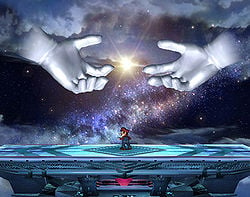
Master Hand appears in both Super Smash Bros. and its sequel Super Smash Bros. Melee as the final boss of Classic Mode and the 50th Event match "Final Destination Match". Super Smash Bros. Melee introduced a left-hand counterpart to Master Hand named Crazy Hand, which appears alongside Master Hand in some scenarios. Master Hand also makes several appearances in Kirby & the Amazing Mirror as a miniboss, and partnered with Crazy Hand as the bosses of Candy Constellation. He also makes an appearance in Kirby: Squeak Squad as a gray hand that can shift its shape to form swords and the like.
Master Hand and Crazy Hand look identical aside from their laterality, but Crazy Hand's fingers act more erratically and chaotically. While Master Hand is more relaxed and mature, Crazy Hand is impulsive and destructive and his fingers move differently when he is preparing for an attack. His attacks are wilder and faster than those of Master Hand, hence his name. When being fought simultaneously, Crazy Hand and Master Hand are able to execute moves together, including a series of claps, and the two hands making fists.
Super Smash Bros. also introduced Metal Mario (originally from Super Mario 64) and a Giant Donkey Kong. Metal Mario is basically Mario, but with increased resistance to being knocked out of the stage as well as a faster falling speed and more attack power, while Giant Donkey Kong is a larger and more powerful version of Donkey Kong. Super Smash Bros. Melee's Adventure Mode introduced more boss characters that were enhanced versions of playable characters, such as the Tiny Donkey Kong duo, Giant Kirby, and Metal Luigi. However, due to items introduced in Melee, such as the Metal Box, Super Mushroom and Poison Mushroom, all of these seemingly non-playable characters (including the enhanced characters that were unplayable bosses in the first game) are indeed playable for short amounts of time as they allow all characters to become Metal, Giant or Tiny. Dark Link, a completely black form of Link, appeared in Melee as a non-playable character. In Super Smash Bros. Brawl, gamers are able to play as Dark Link in the form of a color change for Link.[10]
Giga Bowser, known in Japan as Giga Koopa (ギガクッパ), is the giant and powered up version of Bowser introduced in Smash Bros. Melee. He is the secret final boss of Melee's Adventure Mode, only appearing if the player clears Adventure Mode on Normal mode or higher in 18 minutes or less without using continues. Beat him without using a continue to get his trophy. He is also one of the fighters in the final match of Melee's Event mode Event 51: The Showdown (where the player fights Giga Bowser, Ganondorf, and Mewtwo). Giga Bowser has several abilities that the regular Bowser does not. He is so large that he is immune to grabs and similar grabbing moves. As with Metal Mario, Giga Bowser becomes playable for short periods of time in the following game, Super Smash Bros. Brawl, when Bowser performs his "Final Smash" attack. Bowser transforms into Giga Bowser, and is practically invincible until the effect of the Final Smash wears off.[11]
Super Smash Bros. Brawl's adventure mode, The Subspace Emissary, also features boss characters.[12] Some of these characters, such as Petey Piranha, are characters borrowed from other franchises.
Others are original and are only in Super Smash Bros.; namely, Galleom, Duon and Tabuu.
Super Smash Bros. 4 also has bosses that appear on regular stages, such as Ridley on Pyrosphere, Yellow Devil on Wily Castle, and Dark Emperor on Find Mii The game also has an extra boss named Master Core, which only appears on higher intensity on Classic Mode.
Super Smash Bros. Ultimate adds new bosses that show up at the end of Classic Mode and in the World of Light mode, such as Marx, Rathalos, and Ganon. There are also several returning bosses, including Master Hand, Crazy Hand, Galleom and Giga Bowser.
Finally, there are the two main antagonists of World of Light, Galeem and Dharkon.
Mysterious Small Fry Enemy Corps[edit]
The series' Multi-Man Smash modes pit players against a horde of generic enemies that function near-identically to select fighters, minus effects and special moves, and having their sheer numbers offset by higher knockback and lower AI.
- Fighting Polygons (or "the Fighting Polygon Team") are metallic-looking purple clones of playable characters made completely out of crude polygons in Super Smash Bros. 64. The next to last level in the game contains 30 of these clones of existing Smash 64 characters. They use near-perfect models as their character-counterparts with minute changes to their anatomy, and with a purple texture.
- In Smash Bros. Melee, the Fighting Polygons are replaced by the Fighting Wire Frames. Unlike the original game, there are only two types of Fighting Wire Frames (Male and Female) as opposed to a Polygon corresponding to each individual character base. The only distinct characteristics Fighting Wire Frames have is that there is a Heart inside their chest and the Super Smash Bros. logo where their face should be. Both the male and female Fighting Wire Frames possess these. Male and Female Wire Frames have the frame and gait of Captain Falcon and Zelda, respectively.
- In Super Smash Bros. Brawl, the Fighting Alloy Team supersedes both other teams and come in four colors, shapes, and sizes. They have the frame and gait of Captain Falcon, Zelda, Mario, and Kirby.
- In Smash Bros 4 , they were replaced by Fighting Mii Teams. They wear a black shirt that has the letter M, instead of a crudely made model of another character. There are three different types of Fighting Mii Team members.
Common enemies[edit]
Along with Melee's Adventure Mode came the inclusion of minor, generic enemies, such as Goombas from the Mario franchise and Octoroks from the Zelda franchise. This trend continues into Super Smash Bros. Brawl to an extent; only enemies from the Mario series reappear (Goombas, Hammer Bros, Bullet Bills, and Koopa Troopas) due to Bowser's hands-on role in the SSE as a villain. Waddle Dees also appeared in a cutscene, but they never showed up as regular enemies. Brawl's adventure mode also includes an assortment of original characters to serve as non-playable generic enemies led by the Subspace Army.
Subspace Army[edit]
The Subspace Army are the antagonists of Super Smash Bros. Brawl, appearing in The Subspace Emissary and led by the Ancient Minister. Their goal is to bring the entire World of Trophies into Subspace piece by piece with devices called Subspace Bombs (detonated with the aid of two R.O.B.s), though their motives are a mystery. Among their foot soldiers are the Primid, the primary offensive force of the Subspace Army, said to come in various forms to do battle.[13] They can be seen forming out of strange purple spores that clump together. A variety of other enemies exist; along with the R.O.B. Squad, assorted original enemies include Bytans, small spherical enemies capable of self-replication; Greaps, large robotic figures that attack with large sickles; and Trowlons, enemies with trowel-like bodies that attack by lifting opponents, among many others.[14]
Sandbag[edit]
Sandbag (サンドバッグくん, Sandobaggu-kun) appears in the "Home-Run Contest" minigame in Super Smash Bros. Melee, Super Smash Bros. Brawl, Super Smash Bros. 4, and Super Smash Bros. Ultimate. The object is to strike it as far as possible with either a supplied Home-Run Bat or a fighting move. Sandbag's only purpose is to get hit in the Home-Run Contest. Being hit all the time does not hurt it; it actually loves to see players "wind up and let loose," according to the trophy description. During the actual Home-Run Contest challenge, a player will use their chosen character to hit Sandbag off the pedestal on which it rests within ten seconds. Players damage Sandbag as much as possible while keeping on the orange platform so that it will fly farther. In Brawl, the "Home-Run Contest" also features two-player modes, online play, and a shield that keeps Sandbag on the platform while it is being damaged. Players may also practice by attacking Sandbag while online multiplayer matches load.
Trivia[edit]
- Masahiro Sakurai stated in a YouTube video that Satoru Iwata came up with the title of Super Smash Bros. (大乱闘スマッシュブラザーズ in Japanese). Iwata explained that while very few of the characters in the game are canonically brothers, the title implied that the characters had personal connections and were not simply fighting each other for no reason, as if they were all friends settling a little disagreement.[15]
References[edit]
- ^ Masahiro Sakurai. How this Game Came to be Made. Smash Bros. DOJO!!. smashbros.com. Archived from the original on 2006-07-17.
- ^ David Radd (2006-11-17). Opinion: Wii Won't Rock You. GameDaily. Retrieved on 2006-11-27.
- ^ Wi-Fi Play. Smash Bros. DOJO!!. smashbros.com (2007-09-18). Retrieved on 2007-09-18.
- ^ Four Kinds of Control. Smash Bros. DOJO!!. smashbros.com.
- ^ Names. Smash Bros. DOJO!!. smashbros.com.
- ^ Super Smash Bros. Isn't Finished Being Made. Kotaku.
- ^ Smash Bros. Could be its Creator's Last Game. Kotaku.
- ^ Super Smash Bros. is coming to Nintendo Switch!.
- ^ Super Smash Bros. Ultimate - E3 2018 - Nintendo Switch.
- ^ Video of Dark Link in the Brawl Demo made available at EforAll 2007.
- ^ Bowser's page on the official Super Smash Bros. Brawl website. Smash Bros. DOJO!!. smashbros.com.
- ^ Petey Piranha. Smash Bros. DOJO!!. smashbros.com.
- ^ The Subspace Army. Smash Bros. DOJO!!. smashbros.com.
- ^ The Enemies From Subspace. Smash Bros. DOJO!!. smashbros.com.
- ^ Mr. Iwata [Grab Bag]
External links[edit]
| Super Smash Bros. series | |
|---|---|
| Super Smash Bros. · Super Smash Bros. Melee · Super Smash Bros. Brawl · Super Smash Bros. 4 (for Nintendo 3DS · for Wii U) · Super Smash Bros. Ultimate |


